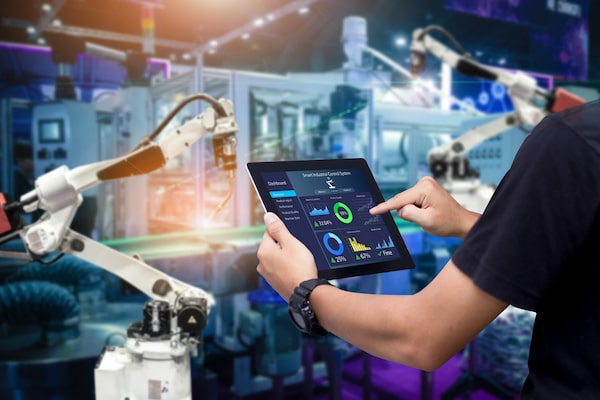
For organizations, the future will be one where automation and cobots will have to be managed along with human workers, which will mean new challenges for leaders.PANUWAT/iStockPhoto / Getty Images
The fourth industrial revolution was all about technology and the fifth industrial revolution is about using that technology to meet societal goals and fashion a human-centric future of work. Other parts of the world have already embraced the idea of this new ‘Industry 5.0,’ and it would seem to be time for Canada to do the same.
If it seems that the industrial revolutions are coming at us more quickly than they used to, that is because they are. The first one took place in the late 1700s, as steam power and coal came to the fore. About 100 years later, in the 1870s, the assembly line and the division of labour were added to the manufacturing industry, which jump-started the second industrial revolution. The third one came about from the computing advances that started in the 1960s, and the fourth started around 20 years ago and is about cyber physical systems and the internet of things. The fourth one happened at breakneck speed, which has heralded much discussion and worry about what it all means for the future of work and really the future of everything because technology is advancing at a pace far above the historical norm.
The fifth industrial revolution is all about technology too, but it is also about how technology can be used to improve society. The European Commission has taken a lead role, putting out a paper earlier this year titled Industry 5.0 and the future of Work: Making Europe the centre of gravity for future good-quality jobs, which sets out strategy to do just that. One point it makes is that as important as skills around STEM are and will continue to be, success in Industry 5.0 will also require the development of emotional and soft skills, and that the new skill set for the future must be composed of “a mix of cross-cutting hard and soft skills, as well as IT skills that allow for optimal interaction with increasingly intelligent machines, which promised to commoditize mainstream existing knowledge, automating also non-routine tasks,” all of which will require continuous learning. The next generation of so-called soft skills.
Japan announced plans around Industry 5.0, as far back as 2016 talking about ‘Society 5.0′, defined as “A human-centred society that balances economic advancement with the resolution of social problems by a system that highly integrates cyberspace and physical space.” In terms of workers, Industry 5.0 means letting automation and robots do the repetitive tasks and freeing workers to do other things, which is a practical consideration in a country where the aging population means that 40 per cent of the workforce is expected to retire by 2040. And so Japan is implementing things like self-driving wheelchairs and the use of robots to provide support to retirees in their own homes and in health care facilities, as well as powering up their manufacturing and energy sectors with new technologies.
If Canada has been dragging its feet on embracing the concept of Industry 5.0, perhaps it is because there is still much distrust around the idea that technology will complement rather than replace workers, and robots are often seen as the enemy rather than as friends. That bias will have to go, given that in an Industry 5.0 world people will increasingly be working with automation, almost as colleagues. We have seen ‘collaborative robots’ or cobots used here over the past few years, but they are going to be centre stage in the near future, on factory floors and in many other workspaces as well. Whether you work in a hospital, restaurant or office, your new colleague may well be a cobot and, the same as working with any human, that will have its challenges.
For organizations, the future will be one where automation and cobots will have to be managed along with human workers, which will mean new challenges for leaders. Workers will have to constantly re-skill and learn to work with machines on a scale that is much more ambitious than anything we have seen to date. More broadly, industries will be re-made in ways that incorporate different and better technologies, hopefully with better outcomes in terms of their environmental impact but also with new implications for the way people work and the skills that are needed. Being afraid of that future (as arguably many have become with the unveiling of the latest advances in artificial intelligence) will not be to the benefit of anyone. Instead, Canada needs a strategy around harnessing the changes and we need to set our own goals as to what Industry 5.0 should look like both for the overall economy and for our labour force.